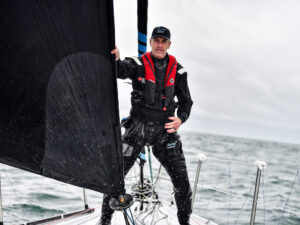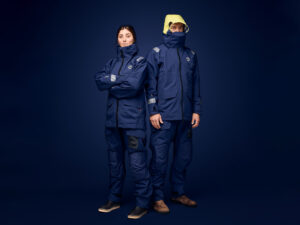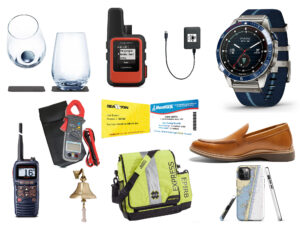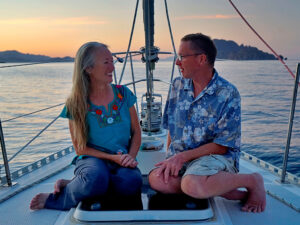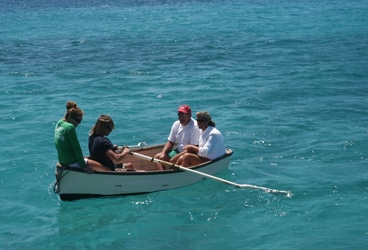
Fatty Knees dinghy
We recently visited a marina with separate dinghy docks for inflatable and hard dinghies. I must say that I was shocked by this visual reminder of the disproportionate number of inflatable boats in service these days. Unable to think of any good reason for this, I asked the owners of inflatables why they chose these boats. Here is what they said, and here are my responses:
“An inflatable is more stable, and I can snorkel and dive from it.”
A hard dinghy of the right design can be equally stable. Just as there are the fast, tender sports cars of hard dinghies, there are also comfortable, stable “Cadillac” versions. The trick is to choose a dinghy designed for how you use it. We can easily climb into our Fatty Knees, Eureka, from the water when it’s wearing its flotation collar.
“It won’t sink.”
When built with watertight compartments to provide positive flotation, wooden and fiberglass dinghies will not sink, either. The difference is that when there is a small hole, even above the waterline, an inflatable will indeed sink, unlike its fiberglass or wooden cousin.
“I can deflate it to stow it more easily.”
True, however, no one who gave me this reason does so on a regular basis. And, inflatable dinghies with a rigid bottom no longer meet even this expectation.
“It is softer for when you come alongside a boat.”
I am not sure “soft” is a word I would want to use to describe a dinghy that must contend with wooden and concrete docks, rocks and sand, and other dinghies whose inconsiderate owners lift the outboard at the dinghy dock. While all these conditions will cause damage to a hard dinghy, they will not render it punctured and useless and leave us stranded on shore within a few hours. A proper rub rail on a hard dinghy is essential to protect it and anything it touches.
To my mind, here are five good reasons for owning a hard dinghy rather than an inflatable.
Life expectancy: A properly maintained hard dinghy built of just about any material can outlive its owner, while an inflatable regularly carries about a five-year guarantee, and in the tropics can become too sunburnt to be worth patching within that time frame, give or take a few years. Many cruisers cover their inflatable tubes to help minimize the Hypalon’s sunburn, but this added expense and hassle often frustrates them enough to make buying a new dinghy their best option. While the price of each type of dinghy is nearly equal, anyone who plans to cruise for several years should count on having to buy more than one inflatable, thus proving them the more expensive option over time.
Self sufficiency: A reasonably competent owner can maintain and repair a hard dinghy himself, perhaps even build it himself. However, I have yet to hear of anyone successfully building their own inflatable, and even attempts to repair one are often not successful long-term options.
Weight: Our eight-foot fiberglass dinghy weighs 85 pounds. We lift it to store on the foredeck with a halyard; and being the winch grinder, I am ever conscious of dinghy weight. In order to have the same interior volume as our eight-footer, an inflatable would have to be 12 feet long and would weigh nearly 150 pounds—without the motor. Raising such a large dinghy on deck is so difficult that most cruisers chose to use davits. Otherwise, they tow their $3,000-means of transportation behind them, often dragging their equally expensive motor, as well.
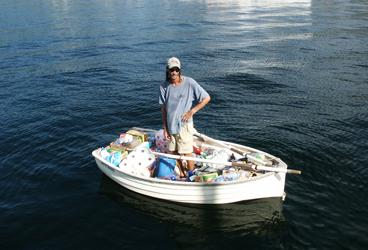
_The Fatty Knees loaded with provisions**
**_
The optional outboard: Because of their hull shape, an inflatable is impractical to row to windward for any distance, making an outboard no longer optional as it is with a hard dinghy. Adding an outboard into the equation makes owning an inflatable that much more of a hassle.
As we watch our cruiser-neighbors in the anchorage jerk on the starter cord of their outboards, we’ve noted that when the engines fail to start, often the cover comes off. It’s then we start a timer. Once the motor is finally running we calculate the expense of spending that much time working on an outboard. At this point, there are usually tools involved, cursing, bloody knuckles, greasy shorts, sweaty shirts, and no hope of gaining any pleasure from an outing to shore.
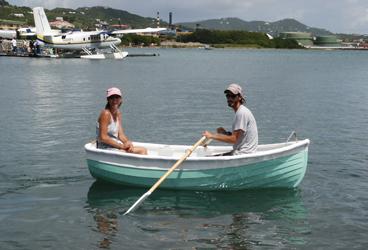
When—not if—the motor does not start, is out of fuel, or feels like being generally uncooperative, in a hard dinghy one is merely inconvenienced. The inflatable owner, however, will be accepting a tow from us as we row past.
I greatly enjoy our quiet, motor-less ventures away from the boat. Our most serious discussions and best laughs have been in our dinghy. We have watched raccoons flip over rocks on shore, manta rays, sharks, and countless turtles swim by, all undisturbed by fumes or noise.
And lastly, the sailing option: Whether at the mercy of financial constraints or Mother Nature’s fancy, we often spend longer in port than our wanderlust appreciates. At these times having a dinghy with a sailing rig helps quench our thirst for adventure. We often sail Eureka to private beaches for a romantic picnic, take her offshore fishing, explore reefs, and sail her to shore to do chores. There is also no better way to learn the nuances of sailing, or to teach them to your children, than with a sailing dinghy.
Whereas most inflatables are known simply as “tender to,” hard dinghies have personalities, become members of the crew and family, and are rightly named. They tag along behind us in the anchorage and forlornly wait for our return when we leave them tied to the dock. Like the pets our children had on land, hard dinghies are our toys and playmates, rather than just a deflatable means of transportation.
Resources
Bauer
Dyer
Fatty Knees
Porta-Bote
Portland Pudgy
Trinka
Walker Bay
West Marine

